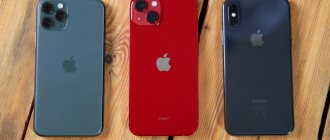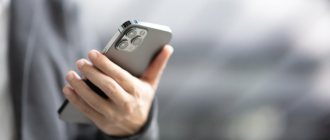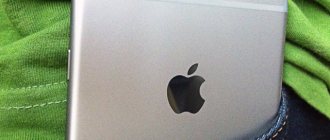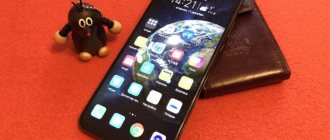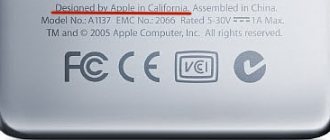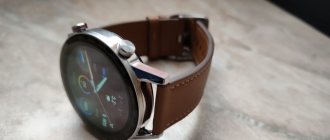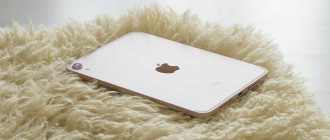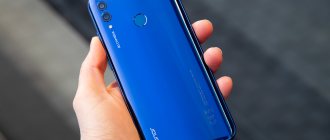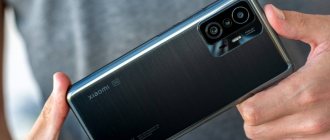This day came. I have in my hands the iPhone 13, which will excite fans of Apple products for a whole year.
When creating this smartphone, Apple generously used its proprietary magic, because at first glance it is the same iPhone 12 in appearance. But once you use it for at least an hour, you catch yourself thinking that this is really a NEW gadget.
Yes, this smartphone has many improvements and advantages compared to the previous flagship. There are also several disadvantages, which I will definitely discuss below.
To be honest, I was looking forward to the Pro version more, because the “pro” prefix automatically makes the gadget cooler, especially from Apple. But having used the iPhone 13, I can say with confidence: in 2021, the functions and capabilities of this smartphone will be enough for most users.
Even if it is not much different from the previous flagship at first glance, you just need to test the new product for at least half an hour to appreciate the work done by the Cupertino engineers.
You can see first impressions of the new iPhones here. And below I will tell you in detail about the iPhone 13, which, like an expensive wine, does not open up immediately, but some time after tasting.
But when you try it, you will be completely delighted.
We still love the flat edges of a smartphone
If you were expecting some completely new design, I have to admit: in the hand, the iPhone 13 feels exactly the same as the iPhone 12.
Personally, I was happy with the flat edges last year, so I’m grateful to the designers who decided not to change anything in the new generation of iPhones. Yes, the smartphone has become a little thicker, but I didn’t even notice it, even holding the iPhone 12 in one hand and the “thirteenth” in the other. The difference of 0.25 mm has absolutely no effect on the tactile perception of the new product.
The body is also made of durable glossy glass with a matte aircraft-grade aluminum frame. The front panel is protected by a proprietary Ceramic Shield coating.
If you look at the screen for a long time, you will notice a reduced cutout in its upper part. In fact, this change gave 20% of the usable space for icons and notifications in the top status bar, but only iPhone 13 mini owners will appreciate this to the maximum. On the fairly large screen of the iPhone 13, the difference with the previous generation is not too noticeable.
The speaker has become narrower and more invisible. I am sure that now the mesh on it will collect less dust. The new cutout does not affect the quality of communication during a call; the interlocutor can be heard perfectly.
Physical buttons, a lever for switching the gadget to silent mode, a Lightning connector and speaker holes are also in the usual places.
The glossy back panel still attracts all fingerprints. So I recommend getting a case right away, given that this season Apple has rolled out new colors of its signature leather and silicone “clothes.” And third-party manufacturers have already come to the rescue, so there is plenty to choose from.
The block of main cameras protruding from the body has become larger and wider, so iPhone 12 cases will not fit. Moreover, this also applies to all other new iPhones.
The cameras themselves also changed their location; now they are not under each other, but located diagonally. This “rebranding” is dictated by technical improvements: now the iPhone 13 and 13 mini have optical stabilization with matrix shift, so that videos are as smooth as possible even in the most trembling hands.
In the previous generation of smartphones, only iPhones with the Pro prefix could boast of this feature.
The camera block lifts the iPhone 13 off the table surface. But the smartphone lies securely and does not wobble if you try to press your finger on the corners.
In addition to purely technical advantages, the changed location of the cameras is the most important visual marker that you have the new iPhone 13 in your hands.
So buy a case with protruding “sides” and place your smartphone with the screen on the table if you want to impress others.
There is no wrapper. That's where she belongs
This is the second year since Apple has made environmental concerns absolute. You can have different attitudes towards the starting point of drastic measures - the disappearance of the charger from the kit. But I definitely don’t want to argue with the new idea.
There is no more wrapper. The boxes of all new iPhones have become “naked”. There are two tamper-evident tabs at the top and bottom of the back of the package. I checked: it is almost impossible to get inside the box without leaving a trace. And the second time you won’t stick those ponytails back the way they were. Moreover, there is no glue on them.
Apple claims that this single solution will save more than 600 tons of plastic per year, which previously inevitably turned into useless waste within the first minutes of unboxing the device. And by 2025, the company plans to completely eliminate any plastic from the materials and contents of equipment boxes.
I note that this initiative affected only the iPhone. The remaining devices presented in September 2022, like those sold previously, are still supplied in a “wrapper”. Someone, of course, will miss the crunch of the film associated with the sacred process of unpacking. But this is not about me.
What colors does Apple have in store for us this year?
Almost the entire palette of the new iPhone 13 in one photo.
In an article with first impressions, Nikita noted that all iPhone 13 have slightly different shades compared to last year’s models. As for me, the colors have become calmer and more pleasing to the eye, especially black, which is now not completely black, but with a slight tint of deep blue.
And it’s called Midnight, which I would translate into Russian as “blue-black” and not “midnight”.
The red iPhone 13 (PRODUCT RED) also became a different shade. It is no longer red, but noble ruby indoors and bright scarlet in the light. Looks more noble than last year's version.
The new pink iPhone doesn't look pink. Such is the paradox. It is rather comparable to the delicate flesh color of the thigh of a frightened nymph. This is how you imagined it now - this is exactly what this color looks like in real life.
Moreover, in the light, the pink iPhone 13 begins to look like baked milk. I would call it the most visually delicious of all the others.
Blue is less intense this season.
The blue color has become lighter. Only about this color I can say that it was better before . Although, in terms of shade, it is closer to the iPhone 12 Pro and Pro Max, which in a similar Pacific Blue color instantly became scarce last season.
And only the white iPhone 13 remained the same white as last year. A classic is forever, in Apple's case for at least one more season.
iPhone 13 specifications
At least one iPhone 12s model, most likely the iPhone 12s Pro Max, maybe the iPhone 12s Pro, will not have any ports at all. Communication with the outside world and charging batteries in models without ports will be carried out wirelessly. It sounds terrible, but if Apple is willing to use this approach in high-end smartphones, then it has answers to all the questions and solutions that will make users of models that still have ports jealous. In extreme cases, it will be possible to get by with the integration of reverse charging, which is also not bad.
It is unlikely that Apple would have decided to take this step if it had not been ready for it. The rumor about bangs (which first appeared during the iPhone X, everyone wanted to reduce bangs) is once again roaming the Internet.
They will keep the bangs, but change their size
This would be nice, but most likely this rumor is destined to be revived more than once. But regarding the Touch ID sensor located under the screen, which will not replace Face ID, but will complement it, there is documentary evidence of Apple’s work on this. Well, if you can’t combine the scanner with the screen, you can use the proven technology of placing Touch ID in the power button, as has already been implemented on the iPad Air 4.
How to live with a screen without 120 Hz
I was surprised to note that the lack of an adaptive change in the screen refresh rate does not spoil the impression of the iPhone 13. Yes, the matrix in the new product remains last year: 6.1-inch diagonal, Super Retina XDR technology with a resolution of 2532 × 1170 pixels and a density of 460 pixels per inch.
But the standard screen brightness has increased and is now 800 cd/m². It's autumn outside our window in full force, and there hasn't been any bright sun yet, but outside the screen looks brighter even with moderate settings for this parameter.
Naturally, True Tone technology and a wide P3 color gamut have migrated to the new product. To summarize all this, I can assure you: the iPhone 13’s screen is still top-notch – rich, with rich colors and a good margin of brightness.
If you need a 120 Hz refresh rate “for show” and to argue with the owners of Android flagships, look towards the Pro versions of the iPhone 13.
In practice, even without this parameter the eyes are comfortable.
Video
Apple announced new video features for the iPhone 13, including a cinematic mode that can automatically change focus as objects move. The company demonstrated the mode's ability to "intelligently" shift focus from an object in the field of view to another object if it changes angle and looks in a different direction.
A pumped battery makes the difference
The new iPhone 13 lasts longer than the iPhone 12 , that's a fact. Thanks to the new, more energy-efficient processor, which we’ll talk about later, and, oddly enough, the lack of a function for adaptively changing the screen refresh rate.
At the presentation, we were promised an increase in autonomy by 2.5 hours for the “thirteenth” and by 1.5 hours for the 13 mini. Personally, I’ve been driving the iPhone 13 for a day now, constantly launching applications and taking photos and videos, and the battery is actually being used more economically.
Graph after using the iPhone 13 for a day. Even in the evening before you put the gadget on charge, there is still quite a lot of energy reserve.
Especially compared to Android flagships, which “melt” right before our eyes even during routine use. I know what I’m talking about - I literally just used one such smartphone as my main one for several weeks. Rarely on any day did he survive until the evening, and once he completely let me down, discharged at the most inopportune moment in the Moscow region, at the time of calling a taxi.
The iPhone will definitely not have such unpleasant surprises during the day . The battery has grown slightly and also has a positive effect on the operating time of the gadget from socket to socket. For this, I easily forgive the 0.25 mm thicker iPhone 13.
MagSafe won't replace Lightning - at least not yet
MagSafe is not yet ready to replace Lightning
Apple definitely won't switch the iPhone to USB-C. So it will lose a significant part of the profit from certification of accessories under the MFi program. But doing away with ports altogether and focusing on MagSafe is a great idea.
However, in 2021 the company is unlikely to abandon Lightning.
The alternative for it is not yet 100% ready for this. On topic: Can Apple release iPhone 13 without any connectors? Yes or no
New cameras, shooting modes and proprietary filters
During all my time working with gadgets in general and smartphones in particular, the examples of photos and videos that I want to show you have come down to several basic points: shooting during the day, shooting at night, shooting moving objects. All smartphones shoot approximately equally well during the day; at night you can notice a difference in color tone and extra noise. Boredom.
For the first time in a long time, the iPhone 13 gave me back the desire to go outside in search of interesting shots. Because I want to take pictures and shoot videos with this smartphone.
The secret is that even if you don’t know how to do this, don’t know about white balance, photosensitivity, focal length and other terms for photographers, you just need to pick up the iPhone 13, point it at any object and tap the shutter button. It turns out perfect.
With similar matrix characteristics of the previous iPhone 12 and the new “thirteenth”, the quality of photos and videos has become almost ideal in the hands of a non-professional layman. Even photographs of the family at grandma’s sideboard, taken in a hurry after a home feast, will look cool.
I'm not talking about slightly more interesting compositions and locations.
The 12-megapixel wide-angle module and the same “ultra-wide” module now take in almost 50% more light during shooting. Moreover, this also applies to night mode - the quality of photos in the dark has improved significantly.
The new cinematic mode pays off, turning any video you shoot into a blockbuster. The feature with blurring the background, which is similar to portrait mode when taking photographs, as well as automatically changing focus from the foreground to the background and back, literally forces you to come up with scenarios, and not just hold the iPhone in your hand in the “I shot it!” I took it!”
And HDR video in the Dolby Vision standard in 4K resolution can be shot at 60 frames per second (previously it was only 30 frames per second).
During the daytime, the videos turn out great. Below is an example recorded with standard settings, without cinematic mode.
When shooting a video, be careful, because if you don’t set the cinematic mode before you start recording the video, then you won’t be able to change the focus from the foreground to the background or vice versa.
Photos on the iPhone 13 are much richer than those taken on last year's iPhone 12 and 12 mini. What I was most pleased with was that the camera stopped “yellowing,” giving the pictures unnatural colors. This is especially noticeable when photographing with zoom.
Photos were taken with 2x zoom in low light conditions.
In general, it is clear that the new iPhone 13 takes excellent photographs outdoors during the day. I didn't expect anything else. It is much more interesting to shoot at night and in dark rooms.
In such conditions, the iPhone 13 feels much more confident than the iPhone 12. Even with maximum zoom, photos are obtained with less “noise” and artifacts.
Photo taken with maximum digital zoom in low light conditions.
Portrait mode also works great in dark locations. The main thing is to find at least some light source.
Even if it is a dim yellowish light bulb high on the ceiling.
The photo was taken in portrait mode, the light source is weak. The iPhone 13 did a great job.
Outdoors at night, the iPhone 13 collects all the scattered light to produce a bright picture. Look at the photo below - it’s hard to guess that they were taken late at night, and the residential building is not lit at all in reality.
In the photo it seems that it was photographed at dusk and there is still quite light around. Bravo, iPhone 13.
Photos were taken without zoom late at night.
In general, photos from the iPhone 13 have less noise in dark places, the lines of objects in the pictures are clearer, and the color rendition is more neutral. Things are a little worse with macro photography; it’s better not to experiment with “close-ups”. We've already checked.
To improve your photos, you can use the built-in photo styles, which change the color tone of the photo and can even convert it into a spectacular black and white version.
What's included?
Everything is predictable and exactly the same as a year ago.
In boxes with any iPhone 13, be it mini or Pro Max, the contents are the same: a USB-C to Lightning cable, a sticker logo, as well as brief reference and warranty information. Another paperclip, where would we be without it?
The iPhone display is again covered with an opaque sticker. You remove it, press the power button - and that’s it, initial setup. All current models ship with iOS 15, and the process is no different from, say, the initial setup of an iPhone 11 on the same firmware.
New processor, new speeds
Inside the iPhone 13 there is a new A15 processor made using a 5nm process. It has 6 cores - 2 high-performance and 4 energy-efficient. The processor began to consume even less energy to operate, and the number of operations it can process per unit of time flew into space: almost 16 trillion per second.
In practice, the difference is not too noticeable, although in fact everything happens a little faster on the iPhone 13 than on my previous iPhone 12 Pro.
This is perceived as something obvious, and only by forcing yourself to follow the sensations, you can notice how transitions between several hundred tabs in Safari occur without microlag, how Siri responds faster, YouTube or a heavy presentation opens.
There is definitely a performance increase and the iPhone 13 will remain a fast and relevant smartphone for several more years. Now there are no such applications or games to load the new processor to the limit, and the absence of lags and freezes - we, iPhone owners, have long been accustomed to this.
Performance
The new A15 Bionic chip is used. Subjectively, the smartphone began to work faster than its predecessor, this concerns application loading and rendering speed. I’m not used to relying on all sorts of tests - you know very well that the 12 Pro Max worked quickly, and the 13 Pro Max also gives speeds. The resources of the new processor will also be used in working with the camera and various complex programs.
I repeat, there is no USB Type-C here, but Apple offers to edit video directly on the iPhone. It seems strange, but, on the other hand, take TikTok: can such a video be edited well on a phone? Can. Need to! Or if you really shoot a lot of videos, then install the LumaFusion program - a great thing for amateur editing. Although it is becoming increasingly difficult to separate one from the other, our colleague Ilya Kazakov collects minute-long reviews of all sorts of things at LumaFusion, and it turns out well.
As before, you can install a second SIM card—we’re talking about eSIM—and make yourself a second Telegram profile. This is convenient, for example, for the same Avito, but the second number can be fed to delivery services.
From what was noticed during the short-term operation. It seems that AirPods Max and other AirPods connect a hundred times faster, and the same applies to CarPlay. I have a 2018 MINI Countryman, one of the first cars on the market to feature wireless CarPlay. He has seen many different iPhones, I responsibly declare: this is the fastest and most reliable connection.
In the title picture you can see a very strange setup: this is an iPhone 13 Pro Max, plus a portable Chord Mojo DAC, plus Audeze Penrose, plus Tidal, MQA subscription. Naturally, everything is connected with cables.
There are two thoughts here: it’s not for nothing that Apple doesn’t announce support for its Lossless with branded headphones. If you remember, this caused many AirPods owners to have their butts burning. And it’s simple: Bluetooth, in fact, like Lightning, does not allow a huge amount of data to reach another device quickly and in full. Therefore, if you want to listen to music well, then here is one of the solutions.
Thought two: It's amazing what a music machine the iPhone has become over the years. When I had my first iPhone, I didn't even think about such variety. I had original wired headphones, then I had a blast with Bowers & Wilkins P5, then the wireless era came, AirPods appeared. And now the owner of an iPhone has thousands of options to ensure great sound. I understand that not everyone wants to bother with cables in the wireless era, but, alas, there is no way to do without it in audiophile.
